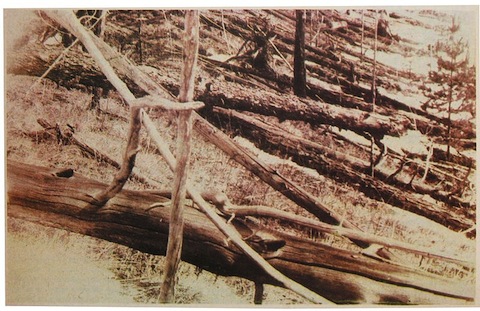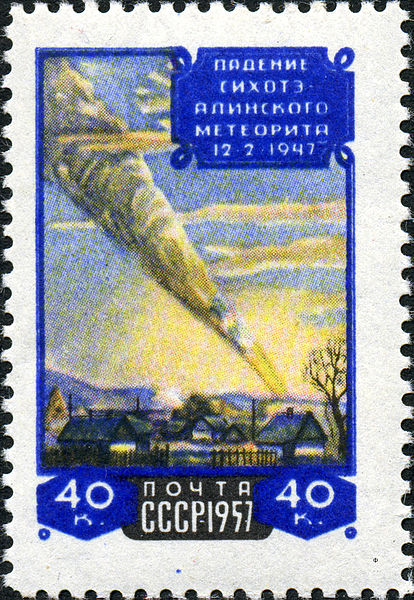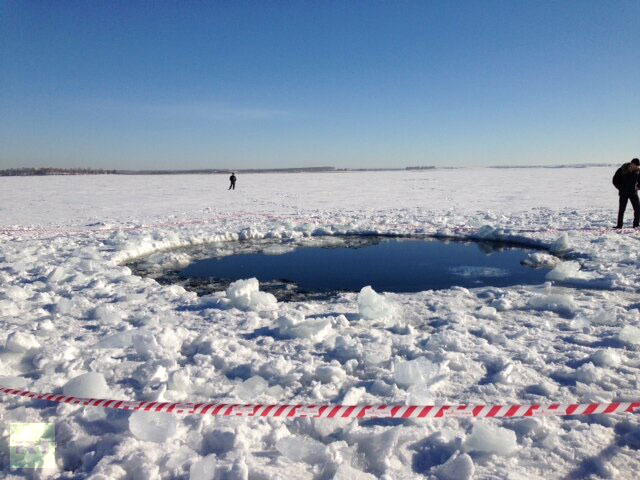Russia's Other Meteor Explosions
The Internet is ablaze today* over astounding pictures and video from Chelyabinsk†, a mid-sized city in Russia's Ural Mountains about a hundred miles from the border with Kazakhstan, which show what appears to be a flaming meteorite streaking across the sky before exploding at high altitude (for the latest updates on this story, check out Phil Plait's Bad Astronomy blog over at Slate). The brilliance of the object as it moved across the sky rivaled the sun, and the shock wave from the explosion below out windows in the city below, causing over 1,000 injuries.
This video shows the course of the fireball across the sky:
Another video, taken from a car dashboard cam:
And this video, shot a few moments later, features at the 27-second mark the massive shock wave that broke thousands of windows across the region:
A falling fragment reportedly punctured the ice on Lake Chebarkul:
This is not the first time a celestial object has wreaked havoc over Russia. On June 30, 1908 (June 17 on the Julian calendar, which Russia used until 1918), an meteorite estimated to be over 300 feet in diameter detonated over the remote Middle Tunguska River in central Siberia, with an estimated explosive yield of 10-15 megatons of TNT -- nearly one thousand times as powerful as the atomic bombs dropped on Hiroshima and Nagasaki (the shock wave was powerful enough to be detected as far away as Great Britain). The Tunguska region was (and remains) remotely populated -- though millions of trees were knocked down and/or burned, there were no direct human fatalities; however, had the meteorite detonated near a city (as the Chelyabinsk meteorite did), the city could have been destroyed.
Even the eyewitness accounts from the Tunguska event show remarkable similarities to the videos and pictures from Chelyabinsk. Eyewitnesses in nearby towns reported "a ball of fire"; "a flying star with a fiery tail"; and "the sky ... open to the ground and fire poured out. ... the sky closed ... and immediately afterward, bangs like gunshots were heard."
Due to the remoteness of the location (and the political turbulence of World War I and the Bolshevik Revolution), the first scientific expedition to the region didn't occur until 1927, lead by Soviet mineralogist Leonid Kulik, with the goal of salvaging remains from the meteorite; however, no impact craters or other remains could be found. Metallic traces from the stellar object were not detected until the 1960s.

Photograph of fallen trees from the 1927 Tunguska expedition.
Various alternative explanations have been proposed for the cause of the Tunguska blast, ranging from fairly the prosaic (an asteroid or a comet) to the unusual (a miniaturized black hole passing through the Earth) to outright bizarre (an nuclear-powered alien spacecraft) to almost mind-bogglingly crazy (an experiment by Nikola Tesla). Perhaps not surprisingly, Tunguska has been frequently used as a backdrop for science fiction writers.
No word on if the Chelyabinsk meteorite will one day form the backstory for a story arc on the inevitable next Star Trek series, but some ... interesting theories are already making the rounds. Russian politican Vladimir Zhirinovsky (inevitably) claimed that the meteor was in fact a U.S. weapons test.
The other documented meteorite event in twentieth-century Russian history occurred over the skies of the Sikhote-Alin Mountains in far eastern Siberia, near the Chinese border, on February 12, 1947. This meteor shower was far more similar to the explosion over Chelyabinsk; an iron meteorite exploded at an altitude of about 3 miles, and considerable debris was recovered.

Soviet stamp commemorating the ten-year anniversary of the Sikhote-Alin meteorite.
* * * * *
*Oddly enough, today was already supposed to be an astronomical red-letter day, as a small asteroid, 2012 DA14, passes close by the Earth today -- closer than the moon. The meteroite over Russia is completely unrelated.
†The Chelyabinsk region just can't seem to catch a break. A small, somewhat obscure town on the edge of Siberia for most of its early history, Chelyabinsk grew exponentially during World War II, when it was dubbed "Tankograd" due to the number of tanks and artillery pieces produced by factories relocated to the city from further west. After the war, the Chelyabinsk oblast (administrative state) became a center for the development and production of nuclear weapons; a radiation leak in at the Chelyabinsk-40 nuclear reprocessing plant about 70 kilometers north of the city in 1957 was the most serious nuclear accident until Chernobyl, and a sizeable portion of the region is still a radiation exclusion zone to this day. Due to the sensitivity of the area's various nuclear installations, both the city of Chelyabinsk and the oblast were closed off to foreigners until the end of the Cold War. Plus, the average annual temperature is 37 degrees Fahrenheit. And now a meteor explodes over the city!
